| 1 | The Mayan serpent deity |
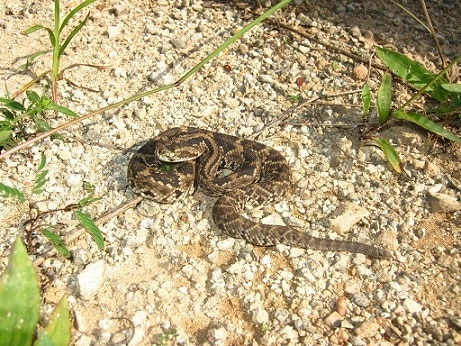
From Canada southwards, almost every corner of the Americas has its own rattlesnake species until central Argentina arrives. Mexico’s Yucatan peninsular is no exception, as this is the realm of the little-known Tzabcan rattlesnake (Crotalus tzabcan), also found in Belize and Guatemala.
This is a chunky brute of a rattlesnake, with a record length of 181.8cm, exceeding the vast majority of US rattlers. The Tzabcan rattlesnake is also slightly deadlier than average, but is most famous for its role in ancient mythology. The Mayan empire revered this rattlesnake, and built numerous columns and temples depicting them in finely sculpted carvings.
Archeological sites such as Mayapan are covered with reverent snake images, and another figure was Ixchel, goddess of herbs and healing in ancient Mayan mythology. Supposedly, Ixchel had 13 sons, two of whom created heaven and hell and everything contained in them. Ixchel sculptures first appeared in the 16th century, and many feature intricate carvings of the Tzabcan rattlesnake, wrapped snugly around her head.
Tzabcan rattlesnakes live nowhere except for the Yucatan peninsular. They live far, far away from their US cousins, although if they look to the north and squint hard enough, they might be able to see an eastern diamondback waving from the Alabama coast.
| 2 | Inhabits dry, crunchy forests |
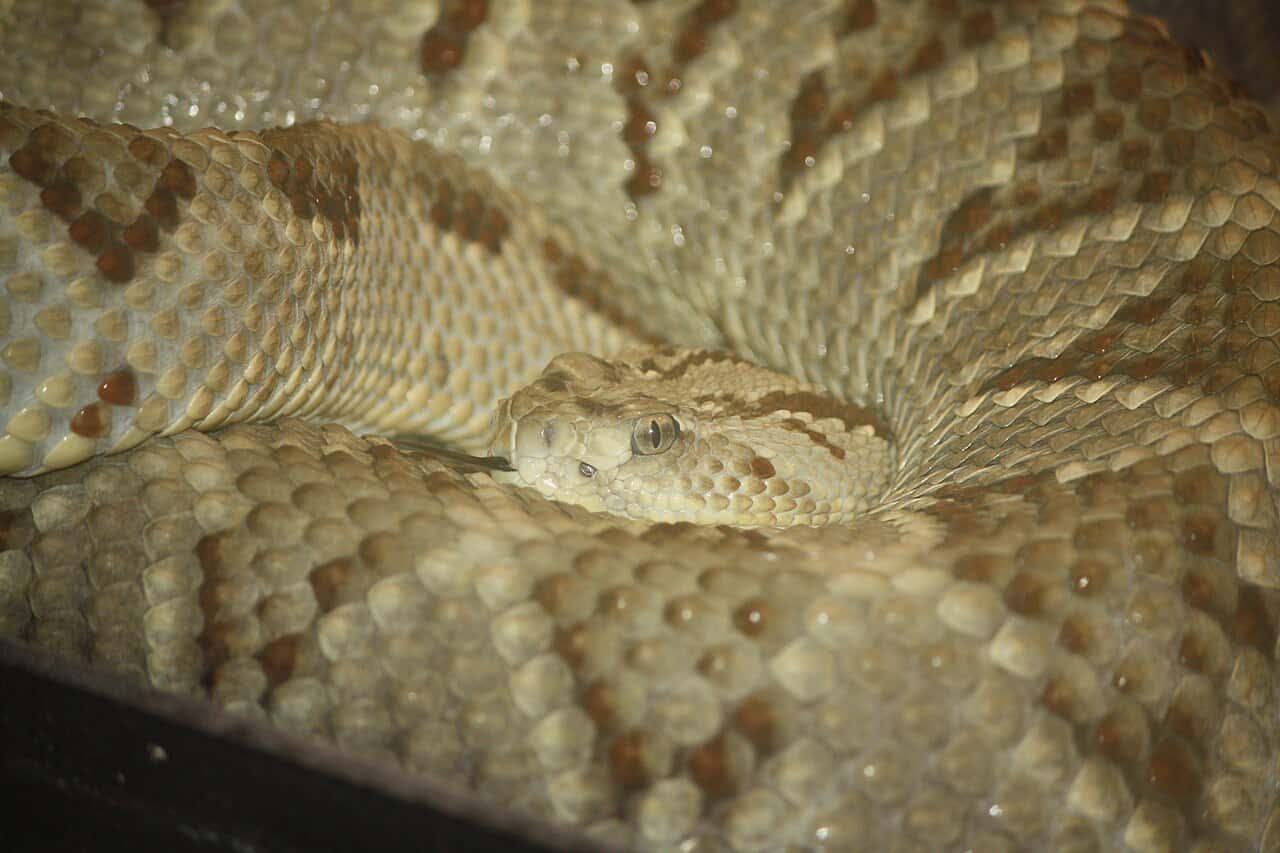
20 years ago, the Tzabcan rattlesnake had very little research to its name, just old Mayan myths and legends. But a fresh batch of studies has made it one of the better studied rattlesnakes away from the USA. Tzabcan rattlesnakes mainly live in forests, including coastal scrub forests, semi-arid dry tropical forests and rainforests. They’re also found basking on dirt roads right next door to forests, and occasionally corn fields where they swallow up the plentiful rodents lurking in between the rows.
This is a remote and secretive snake, which will never sneak into your bathroom and nestle snugly in your towels. In dry forest matter, their camouflage is supreme, blending in with an assortment of twigs and crunchy leaves. Always watch where you’re stepping in the Yucatan peninsula.
Tzabcan rattlesnakes aren’t the only venomous snake of the Yucatan peninsula. Yucatan cantils, fer-de-lances, and variable coral snakes are also slithery creatures which locals have to jump over. However, this is the only rattlesnake around these parts.
| 3 | The secret Mayan cure-all |
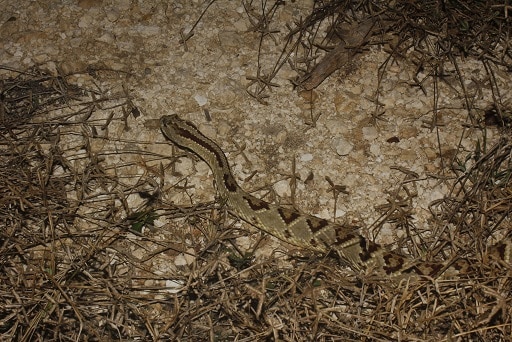
According to Mayan legends, this rattlesnake is the source of one of the most potent medicines known to humanity. It is called “cascabel”, after the local name for all rattlesnakes. While other species are used, the Tzabcan rattlesnake is thought to produce the most potent medicine.
According to lore, no agitated rattlesnake should be used, as the rage flowing through its veins may cause a change in the medicine’s composition. Only calm snakes should be used, and according to Mayan lore, Tzabcan rattlesnakes are particularly calm and docile, with a stronger connection to the gods. The Cascabel medicine reportedly created, and still creates, a supercharged immune system. Today, shamans attempt to use it for aids, diabetes, cancer, severe burns and infections.
Cascabel is made from the entire Tzabcan rattlesnake, not just the venom. The snake is skinned, dried, baked and ground into a fine powder. Just one teaspoon of this powder is said to be enough revitalise your defences.
| 4 | Defensive strategies |
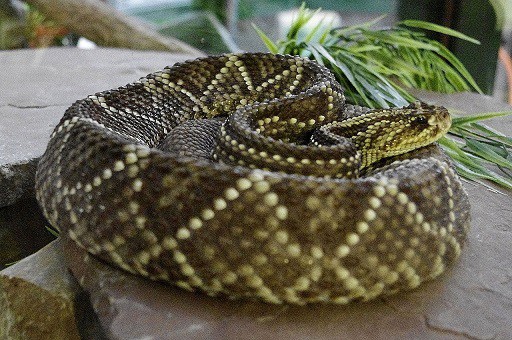
Though reputed to be calm, Tzabcan rattlesnakes will still defend themselves viciously if provoked. How they react to human beings depends on their age. As juveniles, at a length of approximately 30-70cm, Tzabcan rattlesnakes act far more timidly. When a shadow falls and they look up and see a human with a pair of steel snake tongs, they’ll form a tight coil, and stash their head deep in the centre, protecting their brain from predator assault.
They also stay still, allowing their beige camouflage to do the work. Yet another skill is flattening their neck, which isn’t as dramatic as a cobra, but still creates an illusion of increased size, which may be enough to deter a bird.
As adults, Tzabcan rattlesnakes grow more confident, and therefore aggressive. As a mature 150cm serpent, they can rearrange with disturbing speed into a striking pose, with 50% of their upper body raised off the ground. Their chest is kept completely vertical, while their neck kinks sharply, with their head pointing directly at the aggressor. They maintain an unbroken stare, complete with menacing vertical pupils and fangs. Meanwhile, their lower body will be kept in a large open coil, still on the ground. All except their tail and rattle – these are kept raised in the air, allowing them to create a piercing buzzing.
| 5 | A neurotoxic rattlesnake |
In 2013, a study analysed three rattlesnake venoms side by side…
Crotalus culminatus – the northwestern neotropical rattlesnake, found in southwest Mexico.
Crotalus simus – the central American rattlesnake, found in Costa Rica, Nicaragua, Honduras, El Salvador, parts of Guatemala.
Crotalus tzabcan – Yucatan peninsula, Belize, and northern Guatemala.
The verdict was that Tzabcan rattlesnakes ranked in 2nd for lethality, with an LD50 score of 0.47–8.21 μg/g. Crotalus simus was the deadliest, at 0.18–0.65 μg/g, while Crotalus culminatus had the softest, mildest venom at just 3.42–15.9 μg/g. The reason for this was clear – neurotoxins. The main rattlesnake neurotoxin is crotoxins (also found in Mojave rattlesnakes), and Crotalus simus contained easily the most, at 14-17% of total toxins. The Tzabacan rattlesnake featured 3% crotoxins, while Crotalus culminatus contained none at all, relying on the muscle-assaulting myotoxin crotamine instead (also found in east diamondbacks). Tzabcan rattlesnakes were also rich in procoagulants, which deplete blood clotting agents like fibrinogen, causing spontaneous bleeding.
Originally, these three rattlesnakes were subspecies of Crotalus simus, before DNA analysis revealed large genetic chasms between them. The big differences in neurotoxins was one reason behind their separation.
| 6 | Highly variable venom |
In 2017, this neurotoxin experiment was basically repeated. There was a similar verdict: Crotalus simus venom contained the most crotoxin at 7.6–44.3%, depending on the individual. Northwestern neotropical rattlesnakes completely lacked them, with all nine snakes tested scoring zero. The Tzabcan rattlesnake was a mixed bag. Four out of ten produced no neurotoxins, while the remainder contained decent quantities of 3.0-7.7%. On the ground, this means that some Tzabcan rattlesnakes might cause respiratory trouble, slurred speech and twitching eyelids, while others might cause a gruesomely swollen arm.
A 2019 study found that the neurotoxin variety is by geographical location. Tzabcan rattlesnakes from Yucatan province in the peninsula’s northwest had very little crotoxin, with higher proteolytic qualities instead. But those from Quintana Roo province (adjacent to Belize) were far richer in neurotoxins. Likewise, in the 2017 study above, all 6 of 10 containing neurotoxins came from Quintana Roo.
Over 18 rattlesnakes tested, the amount of crotoxin varied from 1.29% to 18.63% of the venom. Those from Campeche state were also richer in neurotoxins, and the Tzabcan rattlesnakes producing more crotoxin also had the genes encoding it. With Belize next door to Quintana Roo, the Crotalus tzabcan here may be of the neurotoxic variety as well.
| 7 | Eats mammals exclusively |
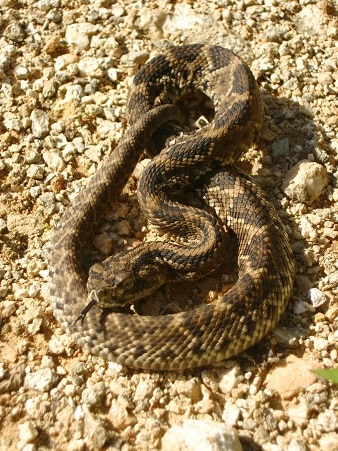
A 2020 study found that this is one of the most mammal-dependent rattlesnakes. 50 Crotalus tzabcan were analysed, including both museum specimens and snakes scooped from the countryside of Mexico’s Yucatán peninsular. In total, 28 prey items were found in their bodies, half-digested. Not all could be identified to the species level, as they were too far gone. But the scientists reached a verdict of 100% mammals, of which 86% were rodents, and 7% Soricomorpha (shrews, voles, etc). The remaining 7% were unidentified.
The study identified their most common prey: Heteromys gaumeri, or the Gaumer’s spiny pocket mouse. This has also been found in the diet of the road guarder, a fast-moving Costa Rican snake. Like other snakes around the world, the Tzabcan rattlesnake loves the taste of Mus musculus, the common house mouse, which originated in southeast Asia, but has spread to every corner of the globe. They have a taste for black rats (Rattus rattus), and one of their largest prey is the Toltec cotton rat. Most mammal-eating rattlesnakes dabble in the occasional lizard, but Crotalus tzabcan is a rare species to have not a single reptile on record.
Other Mexican rattlesnakes include the Baja California rattlesnake, which ate 60.3% mammals in one study, and the lance-headed rattlesnake, which ate 87.9%.
| 8 | Most common during summer |
Tzabcan rattlesnakes are easily one of the larger of the family, dwarfing the tiger rattlesnake at a 91.2cm record. For example, the diet study found that the length of the 50 Crotalus tzabcan ranged from 28.5–181.8cm. While their bodies are roughly equal, males have longer tails, which gives them the overall advantage. The longest female reached 161.9cm.
This 2020 study, meanwhile, revealed aspects of their lifestyle. Crotalus tzabcan was exceedingly secretive and difficult to find, unlike a fer-de-lance, which slithers around all over the place. The best bet was to find one basking on a dirt road, which means that this species commonly ends up as roadkill.
The Tzabcan rattlesnake’s most active period was summer – specifically June 22nd through September 22nd. However, they were active the entire year. The Yucatan peninsular is a warm place whose winter average temperature (22C) is the same as London’s summer average. In July, the average is 26-28C. Consequently, Tzabcan rattlesnakes have no need to enter hibernation, although they do become less active.
| 9 | ID signs to remember |
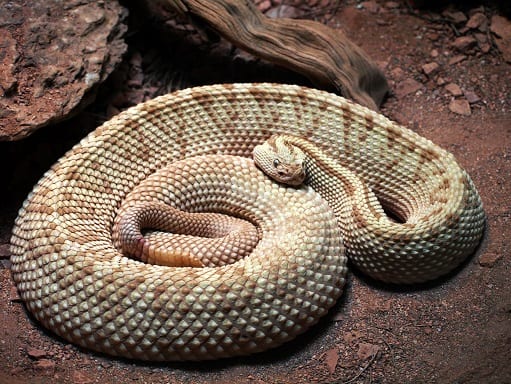
An adult Tzabcan rattlesnake typically has 7 rattle segments. A straight rattle indicates adulthood, while a tapering rattle indicates youth. As an adult, the Tzabcan rattlesnake has a very large head, unlike a tiger rattlesnake’s, which is slender for poking into rock cracks. Tzabcan rattlesnakes have a black tongue, which gets darker towards the tip, while their eyes are grey.
Recognisable signs include a black stripe on their neck which gradually morphs into dark blotches. Males and females of Crotalus tzabcan are almost identical in colour, unlike some venomous snakes. However, juveniles are far darker in appearance. In adulthood, the background fades to a sandy beige, while the blotches finish as a brown or reddish colour (one described as martian red).
The Yucatan peninsula is a relatively dry spot, with some of Mexico’s largest swathes of dry forest. The further inland, the higher the precipitation becomes, as Guatemala and Belize approach. A 2020 study found that precipitation was the reason why the Tzabcan rattlesnake is stuck in the Yucatan peninsula.
| 10 | Reports from the wild |
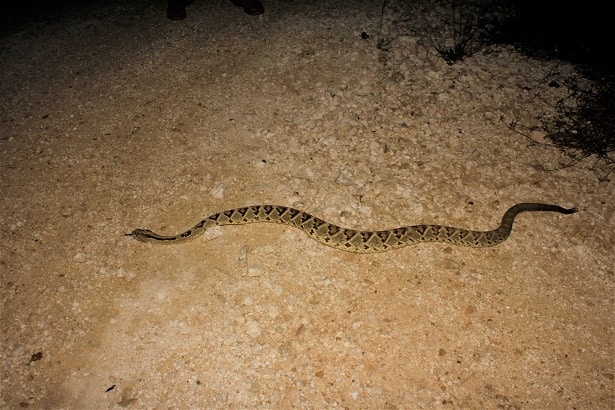
In winter, Crotalus tzabcan is diurnal, while in the height of summer, they’re a nocturnal or crepuscular (dawn and dusk) species. Another interesting tidbit from the diet study is that Tzabcan rattlesnakes ate equal quantities during the wet season and dry season. This rattlesnake isn’t limited by nuisance factors like the weather. As they age, Tzabcan rattlesnakes gradually switch to larger prey, as their jaws can unhinge ever wider. However, they still keep smaller prey in their diet.
Meanwhile, raccoons may be one of their natural predators. In February 2017, scientists on a dusty road found two warring opponents next to each other, dead, 1 metre apart. The racoon had a puncture wound below its leg, as though from a snakebite, while the Tzabcan rattlesnake’s back was covered with messier bite marks.
As well as crotoxins, one of the venom’s most abundant toxins is tzabcanin, a disintegrin which may be used for tracking prey after they’ve been bitten, by altering chemical scents diffusing from their body. Tzabcan rattlesnakes are also excellent swimmers. In 2013, one was spotted crossing open water in Lake Chichancanab in Quintana Roo province. It paused in the centre of the lake, which was 450 metres from the shore.
